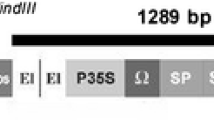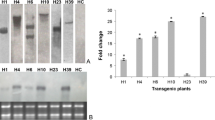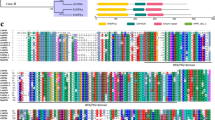Abstract
Currently, there are no resistant sweet orange cultivars to the citrus canker (cc) [Xanthomonas citri subsp. citri (Xcc)], and the production of transgenic plants resistant to cc can be an efficient solution in the search of improved cultivars. Several strategies can be applied in this scenario, including the expression of genes that code for antimicrobial peptides and resistance genes from Xcc-tolerant cultivars. We evaluated the reaction of ‘Hamlin’ sweet orange (Citrus sinensis L. Osbeck) transformed with a gene that codes for the D4E1 synthetic antimicrobial peptide, and ‘Hamlin’ sweet orange plants transformed with the gene that codes for a copper and zinc superoxide dismutase (csd1), isolated from Poncirus trifoliata, after inoculation with Xcc. Transgenic plants were propagated through grafting in ‘Rangpur’ lime (Citrus limonia Osbeck), and then inoculated with a Xcc suspension. Hydrogen peroxide production, activity of selected antioxidant enzymes and callose deposition were evaluated in the transgenic plants subjected to Xcc inoculation. The incidence and the severity of citrus canker were significantly reduced in several transgenic events, which also exhibited lower Xcc titers when compared with non-transgenic plants. Transgenic events which exhibited higher superoxide dismutase activities also showed increased accumulation of hydrogen peroxide in foliar tissues after Xcc inoculation. Epifluorescence microscopy analyses revealed a high callose deposition in the sieve tube elements of leaf tissues in some transgenic events. Callose accumulation is an important plant defense response to biotic stresses and, in csd1 transgenic lines, it was associated with lower Xcc populations.
Key message
Transgenic sweet orange expressing genes by two different disease resistance strategies exhibited less susceptibility to citrus canker with potential to be further studied and integrated into mitigation of this disease.













Similar content being viewed by others
Data availability
The datasets of the current study are presented in this article or are available upon a reasonable request.
References
Albrecht U, Bowman KD (2001) Transcriptional response of susceptible and tolerant citrus to infection with Candidatus Liberibacter asiaticus. Plant Sci 185:118–130
Alexieva V, Sergiev I, Mapelli S, Karanov E (2001) The effect of drought and ultraviolet radiation on growth and stress markers in pea and wheat. Plant, Cell Environ 24:1337–1344
Attílio LB (2013) Transformação genética de laranja doce (Citrus sinensis L. Osbeck) com o gene d4e1 digirido pelos promotores CaMV35S ou AtPP2. 2013. Tese de doutorado – Escola Superior de Agricultura ‘Luiz de Queiroz.’ Universidade de São Paulo, Piracicaba
Azevedo RA, Alas RM, Smith RJ, Lea PJ (1998) Response of antioxidant enzymes to transfer from elevated carbon dioxide to air and ozone fumigation, in the leaves and roots of wild-type and a catalase-deficient mutant of barley. Plant Physiol 104:280–292
Baffana A, Dutt S, Kumar A, Ahuja PS (2011) The basic and applied aspects of superoxide dismutase. J Mol Catal B 68:129–138
Barbosa-Mendes JM, Mourão Filho FAA, Bergamin Filho A, Harakava R, Beer SV, Mendes BMJ (2009) Genetic transformation of Citrus sinensis cv. ‘Hamlin’ with hrpN gene from Erwinia amylovora and evaluation of the transgenic lines for resistance to citrus canker. Sci Hortic 122:109–115
Behlau F (2006) Epidemiologia do cancro cítrico (Xanthomonas axonopodis pv. citri) em laranja “Pera” (Citrus sinensis) sob condições de controle químico e cultural. Universidade de São Paulo, Piracicaba
Behlau F, Belasque Jr J (2014) Cancro cítrico: a doença e seu controle, Fundecitrus: Araraquara, 82p.
Belasque Jr J (2005) Dinâmica espacial do cancro cítrico, interação com a larva minadora dos citros (Phyllocnistis citrella) e diversidade genética do seu agente causal (Xanthomonas axonopodis pv. citri). Tese de Doutorado. Universidade de São Paulo. Piracicaba, SP
Belasque J Jr, Bassanezi RB, Sposito MB, Ribeiro LM, Jesus WCD Jr, Amorim L (2005) Escalas diagramáticas para avaliação da severidade do cancro cítrico. Fitopatol Bras 30:387–393
Belasque J Jr, Gasparoto MCG, Marcassa LG (2008) Detection of mechanical and disease stresses in citrus plants by fluorescence spectroscopy. Appl Opt 47:1922–1926
Boscariol RL, Monteiro M, Takahashi EK, Chabregas SM, Vieira MLC, Vieira LGE, Pereira LFP, Mourão Filho FAA, Cardoso SC, Christiano RSC, Bergamin Filho A, Barbosa JM, Azevedo FA, Mendes BMJ (2006) Attacin A gene from Tricloplusia ni reduces susceptibility to Xanthomonas axonopodis pv. citri in transgenic Citrus sinensis ‘Hamlin.’ J Am Soc Hortic Sci 131:530–536
Boscariol-Camargo RL, Takita MA, Machado MA (2016) Bacterial resistance in AtNPR1 transgenic sweet orange is mediated by priming and involves EDS1 and PR2. Trop Plant Pathol 41:341–349
Bowdish DM, Davidson DJ, Scott MG, Hancock RE (2005) Immunomodulatory activities of small host defense peptides. Antimicrob Agents Chemother 49:1727–1732
Bradford MM (1976) A rapid and sensitive method for the quantitation of microgram quantities of protein utilizing the principle of protein–dye binding. Anal Biochem 72:248–259
Cary JW, Rajasekaran K, Jaynes JM, Cleveland TE (2000) Transgenic expression of a gene encoding a synthetic antimicrobial peptide results in inhibition of fungal growth in vitro and in plant. Plant Sci 154:171–181
Caserta R, Picchi SC, Takita MA, Tomaz JP, Pereira WEL, Machado MA, Ionescu M, Lindow S (2014) Expression of Xylella fastidiosa RpfF in citrus disrupts signalling in Xanthomonas citri subsp. citri and thereby its virulence. Mol Plant Microbe Interact 27:1241–1252
Constantine NG, Ries SK (1977) Superoxide dismutases: I occurrence in higher plants. Plant Physiol 59:309–314
Dutt M, Ananthakrishnan G, Jaromin MK, Brlansky RH, Grosser JW (2012) Evaluation of four phloem-specific promoters in vegetative tissues of transgenic citrus plants. Tree Physiol 32:83–93
Elstner EF (1991) Mechanisms of oxygen activation in diferent compartments of plant cells. In: Pell EJ, Steffen KL (eds) Active oxygen/oxidative stress and plant metabolism. American Society of Plant Physiologist, Rockville, pp 13–15
Enrique R, Siciliano F, Favaro MA, Gerhardt N, Roeschlin R, Rigano L, Marano MR (2011) Novel demonstration of RNAi in citrus reveals importance of citrus callose synthase in defence against Xanthomonas citri subsp. citri. Plant Biotechnol J 9:394–407
Fu XZ, Chen CW, Wang Y, Liu JH, Moriguchi T (2011) Ectopic expression of MdSPDS1 in sweet orange (Citrus sinensis Osbeck) reduces canker susceptibility: involvement of H2O2 production and transcriptional alteration. BMC Plant Biol 11:55
Gabay JE (1994) Ubiquitous natural antibiotics. Science 264:373–374
Gabriel DW, Kingsley MT, Hunter JE, Gottwald T (1989) Reinstatement of Xanthomonas citri (ex Hasse) and X. phaseoli (ex Smith) to species and reclassification of all X. campestris pv. citri strains. Int J Syst Bacteriol 39:14–22
Garran SM (1988) Quantitative resistance to the nursery type of citrus canker. M.S. Thesis, University of Florida, Gainesville.
Gottwald TR, Graham JH, Civerolo EL, Barret HC, Hearn CJ (1993) Differential host range reaction of citrus and citrus relatives to citrus canker and citrus bacterial spot determined by leaf mesophyll susceptibility. Plant Dis 77:1004–1009
Graham JH, Gottwald TR, Riley TD, Achor D (1992) Penetration through leaf stomata and growth of strains of Xanthomonas campestris in citrus cultivars varying in susceptibility to bacterial diseases. Phytopathology 82:1319–1325
Gratão PL, Polle A, Lea PJ, Azevedo RA (2005) Making the life of heavy metal-stressed plants a little easier. Funct Plant Biol 32:481–494
Heath RL, Packer L (1968) Photoperoxidationin isolated chloroplasts: II. Role of electron transfer. Arch Biochem Biophys 125:850–857
Lamb C, Dixon RA (1997) The oxidative burst in plant disease resistance. Annu Rev Plant Physiol Plant Mol Biol 48:251–275
Luna E, Pastor V, Robert J, Flors V, Mauch-Mani B, Ton J (2011) Callose deposition: a multifaceted plant defense response. Mol Plant Microbe Interact 24(2):183–193
Machado MA, Cristofani-Yaly M, Bastianel M (2011) Breeding, genetic and genomic of citrus for disease resistance. Revista Brasileira De Fruticultura, Jaboticabal 33:34–45
Mafra V, Kubo KS, Alves-Ferreira M, Ribeiro-Alves M, Stuart RM, Boava LP, Munari CM, Machado MA (2012) Reference genes for accurate transcript normalization in citrus genotypes under different experimental conditions. PLoS ONE 7:31263–31263
Marques JPR, Soares MKM (2021) Manual de Técnicas Aplicadas à Histopatologia Vegetal, Editora Fealq, 140 p.
Mendes BMJ, Cardoso SC, Boscariol-Camargo RL, Cruz RB, Mourão Filho FAA, Bergamin Filho A (2010) Reduction in susceptibility to Xanthomonas axonopodis pv. citri in transgenic Citrus sinensis expressing the rice Xa21 gene. Plant Pathol 59:68–75
Mentag R, Luckevich M, Morency MJ, Séguin A (2003) Bacterial disease resistance of transgenic hybrid poplar expressing the synthetic antimicrobial peptide d4e1. Tree Physiol 23:405–411
Moraes TS (2015) Transformação genética de tomateiro (Solanum lycopersicum cv. 'Micro-Tom') e de laranja doce (Citrus sinensis L. Osbeck) com o gene csd1 (superóxido dismutase do cobre e do zinco), isolado de Poncirus trifoliata. Tese de Doutorado. Universidade de São Paulo. Piracicaba, SP.
Niidome T, Anzai S, Sonoda J, Tokunaga Y, Nakahara M, Hatakeyama T, Aoyagi H (1999) Effect of amino acid substitution in amphiphilic α-helical peptides on peptide–phospholipid membrane interaction. J Pept Sci 5:298–305
Palazzo DA, Malavolta Júnior VA, Nogueira EMC (1984) Influência de alguns fatores climáticos sobre o índice de infecção de cancro cítrico, causada por Xanthomonas campestris pv. citri, em laranjeira valência (Citrus sinensis), em Bataguassu, M.S. Fitopatol Bras 9:283–290
Pushpanathan M, Pooja S, Gunasekaran P, Rajendhran J (2016) Critical evaluation and compilation of physicochemical determinants and membrane interactions of MMGP1 antifungal peptide. Mol Pharm 13:1656–1667
Quan LJ, Zhang B, Shi WW, Li HY (2008) Hydrogen peroxide in plants: a versatile molecule of the reactive oxygen species network. J Integr Plant Biol 50:2–18
Rajasekaran K, Cary JW, Jaynes JM, Cleveland TE (2005) Disease resistance conferred by the expression of a gene encoding a synthetic peptide in transgenic cotton (Gossypium hirsutum L.) plants. Plant Biotechnol J 3(545):554
Ramakers C, Ruijter JM, Deprez RHL, Moorman AFM (2003) Assumption-free analysis of quantitative real-time polymerase chain reaction (PCR) data. Neurosci Lett 339:62–66
Rigano LA, Siciliano F, Enrique R, Sendín L, Filippone P, Torres PS, Questa J, Dow JM, Castagnaro AP, Vojnov AA, Marano MR (2007) Biofilm formation, epiphytic fitness, and canker development in Xanthomonas axonopodis pv. citri. Mol Plant-Microbe Interact 20:1222–1230
Shaner G, Finney RE (1977) The effect of nitrogen fertilization on the expression of slow-mildewing resistance in Knox wheat. Phytopathology 67:1051–1056
Soares C, Carvalho MEA, Azevedo RA, Fidalgo F (2019) Plants facing oxidative challenges—a little help from the antioxidant networks. Environ Exp Bot 161:4–25
Stover E, Stange RR, McCollum TG, Jaynes J, Irey M, Mirkov E (2013) Screening antimicrobial peptides in vitro for use in developing transgenic citrus resistant to huanglongbing and citrus canker. J Am Soc Hortic Sci 138(2):142–148
Swarup S, Yang Y, Kingsley MT, Gabriel DW (1992) A Xanthomonas citri pathogenicity gene, pthA, pleiotropically encodes gratuitous avirulence on nonhosts. Mol Plant Microbe Interact 5:204–213
Vale FXR, Fernandes Filho EI, Liberato JR, Zambolim L (2001) Quant: software to quantify plant disease severity. In: International Workshop on Plant Disease Epidemiology, Ouro Preto 8:160
Viloria Z, Drouillaerd DL, Graham JH, Grosser JW (2004) Screening triploid hybrids of Lakeland Limequat for resistance to citrus canker. Plant Dis 88:1056–1060
Weydert C, Cullen J (2010) Measurement of superoxide dismutase, catalase and glutathione peroxidase in cultured cells and tissue. Nat Protoc 5:51–66
Yun MH, Torres PS, El Oirdi M, Rigano LA, Gonzalez-Lamothe R, Marano MR, Castagnaro AP, Dankert MA, Bouarab K, Vojnov AA (2006) Xanthan induces plant susceptibility by suppressing callose deposition. Plant Physiol 141:178–187
Zou Z, Xi W, Hu Y, Nie C, Zhou Z (2016) Antioxidant activity of Citrus fruits. Food Chem 196:885–896
Acknowledgements
The authors thank Dr. Marcia Eugenia Amaral Carvalho, for her critical comments on the manuscript, and Dr. Beatriz Appezzato-da-Glória, for providing the structure for histological analysis. The authors also thank Dr. Beatriz Madalena Januzzi Mendes, for technical support during the production of the csd1 transgenic plants, and Dr. Caio Morais de Alcântara Barbosa, for support to produce and organize data into figures. Fundacao Coordenacao de Aperfeicoamento de Pessoal de Nivel Superior (CAPES), Conselho Nacional de Desenvolvimento Científico e Tecnológico (CNPq) INCTII-Citros and Fundação de Amparo à Pesquisa do Estado de São Paulo (FAPESP) for the financial support.
Funding
This work was supported by INCTII-Citros (CNPq 465440/2014-2; FAPESP 2014/50880-0), and Fundação Coordenação de Aperfeiçoamento de Pessoal de Nível Superior (CAPES).
Author information
Authors and Affiliations
Contributions
MLD: investigation, data curation, writing—original draft. TdSM: investigation, data curation. LBA: investigation, data curation, JPRM: investigation, data curation, writing—review & editing. LCLS: investigation, data curation, RH: conceptualization. JF-A: conceptualization. JBJ: conceptualization. RAA: writing—review & editing. SAG: investigation, writing—review & editing. FdAAMF: conceptualization, project administration, writing—review & editing.
Corresponding author
Ethics declarations
Competing interests
The authors have no competing interests (financial or non-financial) to disclose.
Additional information
Communicated by Wenwu Guo.
Publisher's Note
Springer Nature remains neutral with regard to jurisdictional claims in published maps and institutional affiliations.
Supplementary Information
Below is the link to the electronic supplementary material.
Rights and permissions
Springer Nature or its licensor (e.g. a society or other partner) holds exclusive rights to this article under a publishing agreement with the author(s) or other rightsholder(s); author self-archiving of the accepted manuscript version of this article is solely governed by the terms of such publishing agreement and applicable law.
About this article
Cite this article
Docema, M.L., Moraes, T.S., Attílio, L.B. et al. Transgenic ‘Hamlin’ sweet orange expressing csd1 or d4e1 genes exhibits decreased susceptibility to citrus canker disease. Plant Cell Tiss Organ Cult 152, 471–489 (2023). https://doi.org/10.1007/s11240-022-02420-3
Received:
Accepted:
Published:
Issue Date:
DOI: https://doi.org/10.1007/s11240-022-02420-3




